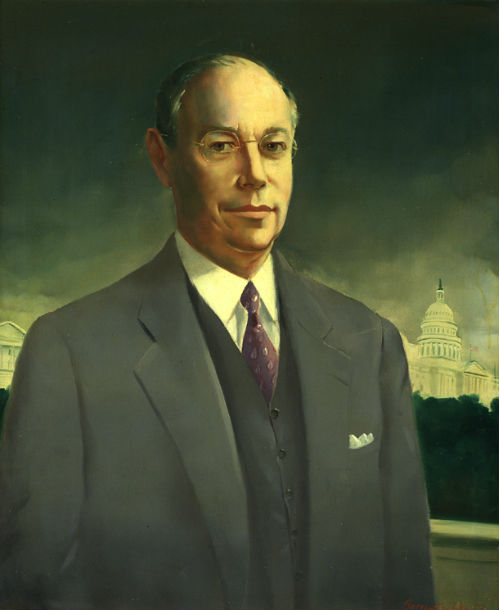
| Title | Robert A. Taft |
| Artist/Maker | Rudolf Anton Bernatschke ( 1913 - 2010 ) |
| Date | 1953 |
| Medium | Oil on canvas |
| Dimensions | h. 29.5 x w. 24.5 in. (h. 74.9 x w. 62.2 cm) |
| Credit Line | U.S. Senate Collection |
| Accession Number | 32.00030.000 |
Rudolf Bernatschke completed this portrait of Robert Taft in 1953, the year of Taft’s death. Just three weeks before the senator died, Bernatschke had the opportunity to show the painting to Taft, who thought it “flattering.” [1] Taft made one request of the artist, however: He asked that the color of his hair at the temples be changed from white to gray.
The Austrian-born Bernatschke, who had immigrated to the United States 18 years earlier, was noted by then for portraiture, landscapes, and still lifes with vivid color and crisp delineation. Bernatschke painted the Taft portrait as a personal tribute, proclaiming himself an “admirer of Senator Taft and a believer in the principles for which he stood.” [2] In 1959 the artist presented the painting to Senate Republicans for display in the Republican leader’s suite of offices in the Capitol. Senator Everett M. Dirksen of Illinois, Republican leader at the time, accepted the painting at a bipartisan ceremony in the Old Supreme Court (now the Old Senate) Chamber, declaring that he would be honored to have this portrait of the “great leader” hang in his office. [3] During the ceremony, Senate Democratic Leader Lyndon B. Johnson also praised Taft as a “brave and fearless leader.” [4] The painting hung in the Republican leader’s suite until 1969.
1. Marie Smith, “Taft Portrait Is Presented at Capitol to GOP Senators,” Washington Post and Times Herald, 18 June 1959.
2. Ibid.
3. Ibid.
4. Ibid.
Born in Cincinnati, Ohio, Robert Alphonso Taft, the son of President William Howard Taft, would one day become the leading spokesman for conservative opinion in the United States. Elected to the U.S. Senate in 1938, Taft opposed President Franklin D. Roosevelt's New Deal programs and efforts to expand the federal government at the expense of state and local jurisdictions. In Congress, Taft chaired the Senate Labor and Public Welfare Committee, where he helped write the Labor-Management Relations Act of 1947. Known as the Taft-Hartley Act, it placed controls on labor unions and prohibited "closed shops." As a member of the Foreign Relations Committee, Taft spoke out on international issues, especially criticizing President Harry S. Truman's Korean and Chinese policies. Identified as "Mr. Republican," Taft enjoyed wide respect for his fairness, courage, and integrity, despite his often controversial positions.
Taft was an unsuccessful candidate for the Republican presidential nomination in 1940, 1948, and 1952. During his brief service as Senate majority leader in 1953, he became a prominent advisor to President Dwight D. Eisenhower. Illness forced Taft to relinquish active Senate leadership in June of 1953, and he died the following month.